Introduction to Arrays of Objects
Introduction to Arrays of Objects
Introduction to Arrays of Objects
Overview
You can create an array of objects in the body of the constructor of a component. As we saw with JavaScript, if you want to signal an array but don't have elements for it, assign empty square brackets to a scoped variable. Here is an example:
var appBusiness = angular.module("appWaterCompany", []);
function create($scope) {
$scope.orders = [];
}
appBusiness.controller("CustomersController", ["$scope", create]);
![]() Practical Learning: Introducing Arrays of Objects
Practical Learning: Introducing Arrays of Objects
body {
background-color: white;
}
.bold { font-weight: 600; }
.tbl-order-nbr { width: 300px; }
.large { width: 360px; }
.medium { width: 150px; }
.small { width: 80px; }
.order-contents { margin: auto;
width: 650px; }
.heading { font-size: 14px;
border-bottom: 2px double black; }
.common-font { font-family: Georgia, Garamond, 'Times New Roman', serif; }var appBusiness = angular.module("appChairExecs", []);
function prepare($scope) {
$scope.orders = [];
}
appBusiness.controller("CustomerOrderController", ['$scope', prepare]);The Array Object
Once again, remember that when you create an array, including an array of objects, it is automatically of type Array.
Adding Objects to an Array
Specifying the Object of an Index of an Array
As we saw in JavaScript, you can apply the square brackets to the name of the array, pass an index in the square brackets, and assign the desired object.
![]() Practical Learning: Specifying the Object of an Index
Practical Learning: Specifying the Object of an Index
var appBusiness = angular.module("appChairExecs", []);
function prepare($scope) {
$scope.orders = [];
$scope.orders[0] = {
orderNumber: 100001,
chair1Name: "Essential", quantity1: 6,
chair2Name: "Director", quantity2: 2,
chair3Name: "Excel Extent", quantity3: 8
};
$scope.orders[1] = {
orderNumber: 100002,
chair1Name: "", quantity1: 0,
chair2Name: "", quantity2: 0,
chair3Name: "Executive", quantity3: 1
};
$scope.orders[2] = {
orderNumber: 100003,
chair1Name: "Instructor", quantity1: 3,
chair2Name: "Scholar", quantity2: 3,
chair3Name: "", quantity3: 0
};
$scope.orders[3] = {
orderNumber: 100004,
chair1Name: "Station", quantity1: 10,
chair2Name: "Scholar", quantity2: 5,
chair3Name: "Executive", quantity3: 2
};
}
appBusiness.controller("CustomerOrderController", ['$scope', prepare]);Adding a New Object to an Array
To add an object to an array, you can define the object in the square brackets. In the same way, you can add many objects in the square brackets. Here is an example:
var app = angular.module('appToys', []);
app.controller('ToysController', inventorize);
inventorize.$inject = ['$scope'];
function inventorize($scope) {
$scope.toys = [{ itemNumber: 937495, toyName: "Mini Point of Sale Station", unitPrice: 32.64 },
{ itemNumber: 309581, toyName: "Drawing Black Board", unitPrice: 18.45 }];
}
An Array of Objects for a Property of an Object
A property of an object can hold an array. To make this possible, create an array and assign it to a named attached to a $scope object. Here is an example:
var app = angular.module("CPARApp", []);
app.controller("CPARController", repair);
function repair($scope) {
$scope.repairOrder = {
parts : [ { partName: "Air Filter", price: 8.95 },
{ partName: "Gasket Intake Manifold", price: 225.67 },
{ partName: 'Front Wheel Hub Bearing Kit', price: 96.88 },
{ partName: "Oil Seal", price: 6.34 } ]
};
}
Pushing an Object to an Array
To let you add an object to an array, we already know that the Array object provides the push() method that you can use. Here are two examples of calling that method:
var app = angular.module('appToys', []);
app.controller('ToysController', inventorize);
inventorize.$inject = ['$scope'];
function inventorize($scope) {
$scope.toys = [{ itemNumber: 937495, toyName: "Mini Point of Sale Station", unitPrice: 32.64 },
{ itemNumber: 309581, toyName: "Drawing Black Board", unitPrice: 18.45 }];
$scope.toys.push({ itemNumber: 749374, toyName: "Kid Ferry Boat", unitPrice: 24.86 });
$scope.add = function () {
var toy = { itemNumber: $scope.stockNumber, toyName: $scope.name, unitPrice: $scope.price }
$scope.toys.push(toy);
}
}
Accessing the Objects of an Array
Introduction
If you know the index of an object in an array, you can access the object from that index. To do this, pass the index to square brackets applied to name of the array. After the closing square bracket, type a period followed by the desired member of the object.
![]() Practical Learning: Accessing an Element of the Array
Practical Learning: Accessing an Element of the Array
var appBusiness = angular.module("appChairExecs", []);
function prepare($scope) {
$scope.orders = [];
$scope.orders[0] = {
orderNumber: 100001,
chair1Name: "Essential", quantity1: 6,
chair2Name: "Director", quantity2: 2,
chair3Name: "Excel Extent", quantity3: 8
};
$scope.orders[1] = {
orderNumber: 100002,
chair1Name: "", quantity1: 0,
chair2Name: "", quantity2: 0,
chair3Name: "Executive", quantity3: 1
};
$scope.orders[2] = {
orderNumber: 100003,
chair1Name: "Instructor", quantity1: 3,
chair2Name: "Scholar", quantity2: 3,
chair3Name: "", quantity3: 0
};
$scope.orders[3] = {
orderNumber: 100004,
chair1Name: "Station", quantity1: 10,
chair2Name: "Scholar", quantity2: 5,
chair3Name: "Executive", quantity3: 2
};
var weight1 = 0, weight2 = 0, weight3 = 0;
var quantity1 = 0, quantity2 = 0, quantity3 = 0;
var subTotal1 = 0, subTotal2 = 0.00, subTotal3 = 0.00;
var totalWeight1 = 0, totalWeight2 = 0, totalWeight3 = 0;
var selection1Price = 0.00, selection2Price = 0.00, selection3Price = 0.00;
$scope.orderNbr = $scope.orders[0].orderNumber;
$scope.type1Name = $scope.orders[0].chair1Name;
$scope.type2Name = $scope.orders[0].chair2Name;
$scope.type3Name = $scope.orders[0].chair3Name;
$scope.type1Quantity = $scope.orders[0].quantity1;
$scope.type2Quantity = $scope.orders[0].quantity2;
$scope.type3Quantity = $scope.orders[0].quantity3;
if ($scope.type1Name == "Station") {
weight1 = 28;
selection1Price = 42.45;
}
else if ($scope.type1Name == "Essential") {
weight1 = 32;
selection1Price = 54.67;
}
else if ($scope.type1Name == "Instructor") {
weight1 = 36;
selection1Price = 68.93;
}
else {
weight1 = 0;
selection1Price = 0.00;
}
if ($scope.type2Name == "Scholar") {
weight2 = 36;
selection2Price = 88.65;
}
else if ($scope.type2Name == "Director") {
weight2 = 38;
selection2Price = 104.25;
}
else {
weight2 = 0;
selection2Price = 0.00;
}
if ($scope.type3Name == "Excel Extent") {
weight3 = 66;
selection3Price = 128.74;
}
else if ($scope.type3Name == "Executive") {
weight3 = 78;
selection3Price = 174.36;
}
else {
weight3 = 0;
selection3Price = 0.00;
}
var quantity1 = Number($scope.type1Quantity || 0);
var quantity2 = Number($scope.type2Quantity || 0);
var quantity3 = Number($scope.type3Quantity || 0);
totalWeight1 = weight1 * quantity1;
totalWeight2 = weight2 * quantity2;
totalWeight3 = weight3 * quantity3;
subTotal1 = selection1Price * quantity1;
subTotal2 = selection2Price * quantity2;
subTotal3 = selection3Price * quantity3;
$scope.type1UnitWeight = weight1;
$scope.type1UnitPrice = selection1Price;
$scope.type2UnitWeight = weight2;
$scope.type2UnitPrice = selection2Price;
$scope.type3UnitWeight = weight3;
$scope.type3UnitPrice = selection3Price;
if (quantity1 != 0) {
$scope.type1TotalWeight = totalWeight1;
$scope.type1SubTotal = subTotal1;
}
else {
$scope.type1TotalWeight = "";
$scope.type1SubTotal = "";
}
if (quantity2 != 0) {
$scope.type2TotalWeight = totalWeight2;
$scope.type2SubTotal = subTotal2;
}
else {
$scope.type2TotalWeight = "";
$scope.type2SubTotal = "";
}
if (quantity3 != 0) {
$scope.type3TotalWeight = totalWeight3;
$scope.type3SubTotal = subTotal3;
}
else {
$scope.type3TotalWeight = "";
$scope.type3SubTotal = "";
}
var shipping = 0.00;
var discRate = 0.00;
var totalPrices = subTotal1 + subTotal2 + subTotal3;
var totalWeight = totalWeight1 + totalWeight2 + totalWeight3;;
if (totalPrices >= 800) {
discRate = 20; // %
}
else if (totalPrices >= 600) {
discRate = 15; // %
}
else if (totalPrices >= 300) {
discRate = 10; // %
}
else {
discRate = 0; // %
}
if (totalWeight >= 200) {
shipping = 42.50;
}
else if (totalWeight >= 150) {
shipping = 36.25;
}
else if (totalWeight >= 100) {
shipping = 24.48;
}
else if (totalWeight >= 50) {
shipping = 18.65;
}
else {
shipping = 12.25;
}
var discAmt = totalPrices * discRate / 100;
$scope.totalWeight = totalWeight;
$scope.subTotal = totalPrices;
$scope.discountRate = discRate;
$scope.discountAmount = discAmt;
$scope.shippingAndHandling = shipping;
$scope.orderTotal = totalPrices - discAmt + shipping;
}
appBusiness.controller("CustomerOrderController", ['$scope', prepare]);<!DOCTYPE html>
<html>
<head>
<meta charset="utf-8" />
<link href="Content/bootstrap.css" rel="stylesheet" />
<link href="Content/ChairExecs.css" rel="stylesheet" />
<script src="Scripts/angular.min.js"></script>
<script src="Scripts/ChairExecs.js"></script>
<title>Chair Executives - Customer Order Review</title>
</head>
<body ng-app="appChairExecs">
<div class="order-contents" ng-controller="CustomerOrderController">
<h2 class="common-font bold text-center">Customer Order Review</h2>
<table class="table tbl-order-nbr">
<tr>
<td class="bold">Order #:</td>
<td>{{orderNbr}}</td>
</tr>
</table>
<form name="CustomerOrderEvaluation" method="post">
<table class="table table-striped">
<tr>
<td class="large heading bold text-center" style="border-right: 3px solid silver">Item Definition</td>
<td class="heading bold text-center">Sale Description</td>
</tr>
</table>
<table class="table table-bordered">
<tr>
<td class="medium bold">Item Name</td>
<td class="bold">Weight(Lbs)</td>
<td class="bold">Unit Price</td>
<td class="bold">Quantity</td>
<td class="bold">Weight(Lbs)</td>
<td class="bold">Sub-Total</td>
</tr>
<tr>
<td>{{type1Name}}</td>
<td>{{type1UnitWeight}}</td>
<td>{{type1UnitPrice | number : 2}}</td>
<td>{{type1Quantity}}</td>
<td>{{type1TotalWeight}}</td>
<td>{{type1SubTotal | number : 2}}</td>
</tr>
<tr>
<td>{{type2Name}}</td>
<td>{{type2UnitWeight}}</td>
<td>{{type2UnitPrice | number : 2}}</td>
<td>{{type2Quantity}}</td>
<td>{{type2TotalWeight}}</td>
<td>{{type2SubTotal | number : 2}}</td>
</tr>
<tr>
<td>{{type3Name}}</td>
<td>{{type3UnitWeight}}</td>
<td>{{type3UnitPrice | number : 2}}</td>
<td>{{type3Quantity}}</td>
<td>{{type3TotalWeight}}</td>
<td>{{type3SubTotal | number : 2}}</td>
</tr>
</table>
<hr />
<table class="table table-striped">
<tr>
<td class="medium bold">Total Weight (Lbs):</td>
<td>{{totalWeight}}</td>
<td style="width: 80px"> </td>
<td class="bold">Sub-Total:</td>
<td>{{subTotal | number : 2}}</td>
</tr>
<tr>
<td class="bold">Discount Rate (%):</td>
<td>{{discountRate}}</td>
<td> </td>
<td class="bold">Discount Amount:</td>
<td>{{discountAmount | number : 2}}</td>
</tr>
<tr>
<td class="bold">Shipping & Handling:</td>
<td>{{shippingAndHandling | number : 2}}</td>
<td> </td>
<td class="bold">Order Total:</td>
<td>{{orderTotal | number : 2}}</td>
</tr>
</table>
</form>
</div>
</body>
</html>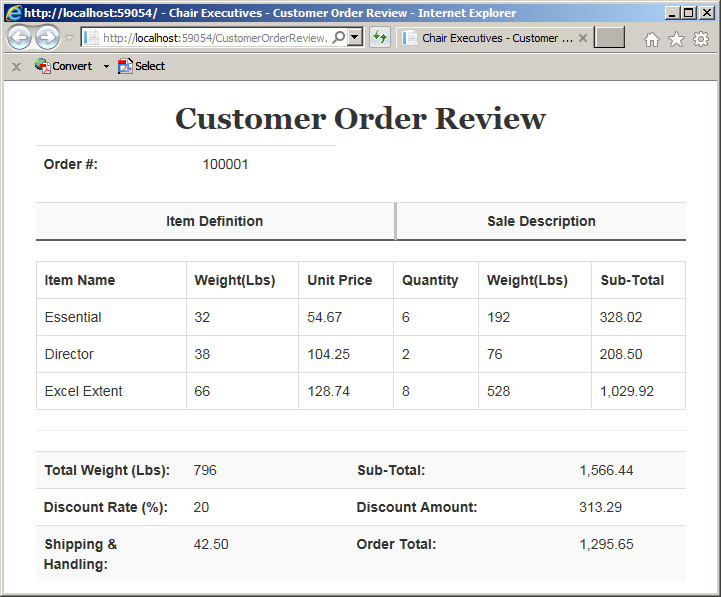
A Repeating Directive for an Array of Objects
We saw that, to support looping, AngularJS provides the ng-repeat directive. When it comes to a table, add an ng-repeat directive to a <TR> tag. Then use its variable-name as the value of the <TD> tag. Here is an example:
<!DOCTYPE html>
<html>
<head>
<meta charset="utf-8" />
<title>Children Toys Store</title>
<style>
.container {
margin: auto;
width: 380px;
}
.bold { font-weight: 600; }
.small { width: 60px; }
.medium { width: 100px; }
.large { width: 200px; }
.centered { text-align: center }
.tbl-inventory { width: 100%; }
</style>
<script src="Scripts/angular.min.js"></script>
</head>
<body ng-app="appToys">
<div class="container" ng-controller="ToysController">
<h1 class="centered">Children Toys Store</h1>
<h2 class="centered">New Toy</h2>
<table>
<tr>
<td class="medium bold">Item #</td>
<td><input type="text" ng-model="stockNumber" /></td>
</tr>
<tr>
<td class="bold">Toy Name:</td>
<td><input type="text" ng-model="name" /></td>
</tr>
<tr>
<td class="bold">Unit Price:</td>
<td><input type="text" ng-model="price" /></td>
</tr>
<tr>
<td> </td>
<td><input type="button" value="Add Toy to Inventory" ng-click="add()" /></td>
</tr>
</table>
<h2 class="centered">Inventory</h2>
<table class="tbl-inventory" border="2">
<tr class="bold">
<td class="small">Item #</td>
<td class="large">Toy Name</td>
<td>Unit Price</td>
</tr>
<tr ng-repeat="toy in toys">
<td>{{toy.itemNumber}}</td>
<td>{{toy.toyName}}</td>
<td>{{toy.unitPrice}}</td>
</tr>
</table>
</div>
<script>
var app = angular.module('appToys', []);
app.controller('ToysController', inventorize);
inventorize.$inject = ['$scope'];
function inventorize($scope) {
$scope.toys = [{ itemNumber: 937495, toyName: "Mini Point of Sale Station", unitPrice: 32.64 },
{ itemNumber: 309581, toyName: "Drawing Black Board", unitPrice: 18.45 }];
$scope.toys.push({ itemNumber: 749374, toyName: "Kid Ferry Boat", unitPrice: 24.86 });
$scope.add = function () {
var toy = { itemNumber: $scope.stockNumber, toyName: $scope.name, unitPrice: $scope.price }
$scope.toys.push(toy);
// Reset the form section that had the new values
$scope.stockNumber = "";
$scope.name = "";
$scope.price = "0.00";
}
}
</script>
</body>
</html>
This would produce:
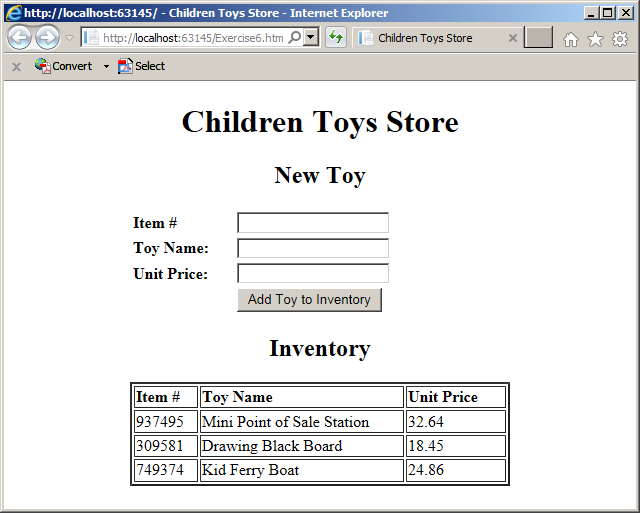
In the same way, if you had specified the value of a property of an object as an array, in the webpage, you can access the property by preceding it with the name of the object. Here is an example:
var app = angular.module("CPARApp", []);
app.controller("CPARController", ['$scope', ['$scope', repair]]);
function repair($scope) {
$scope.repairOrder = {
orderNumber : 100001,
customerName: 'Anthony Schiff',
parts : [ { partName: "Air Filter", price: 8.95 },
{ partName: "Gasket Intake Manifold", price: 225.67 },
{ partName: 'Front Wheel Hub Bearing Kit', price: 96.88 },
{ partName: "Oil Seal", price: 6.34 } ]
};
}
<!DOCTYPE html>
<html>
<head>
<meta charset="utf-8" />
<style type="text/css">
.bold { font-weight: 600 }
</style>
<title>College Park Auto-Repair</title>
<script src="Scripts/angular.min.js"></script>
<script src="Scripts/repair.js"></script>
</head>
<body>
<div ng-app="CPARApp" ng-controller="CPARController">
<h1>College Park Auto-Repair</h1>
<h2>Repair Order</h2>
<table>
<tr>
<td class="bold">Order #:</td>
<td>{{repairOrder.orderNumber}}</td>
</tr>
<tr>
<td class="bold">Customer Name:</td>
<td>{{repairOrder.customerName}}</td>
</tr>
</table>
<hr />
<h2 class="center">Parts Used</h2>
<table border="4">
<tr>
<td class="bold">Past Name</td>
<td class="bold">Price</td>
</tr>
<tr ng-repeat="part in repairOrder.parts">
<td>{{part.partName}}</td>
<td>{{part.price}}</td>
</tr>
</table>
</div>
</body>
</html>
This would produce:
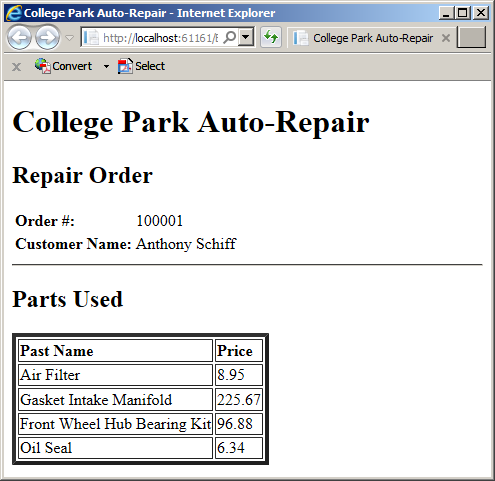
Common Operations on Arrays of Objects
Removing an Element from an Array
To remove an element that exists in an array, you can call the pop()method of the Array class.
An Object is an Array
In our introduction to Arrays and objects in JavaScript, we saw that, when you create an object, each property ( defined in two parts separated by a column) becomes an element of an array and the object becomes that array. Here is an example:
<script>
var appModule = angular.module("billsModule", []);
appModule.controller("BillsController", present);
function present() {
this.customers = ["Joseph", "Patricia", "Anthony", "Valerie", "Cynthia"];
this.states = {
8: "DC",
6: 'MD',
0: "PA",
7.50: 'VA',
7.75: "WV"
};
}
</script>
You can then use the properties of the object as an array. For example, you use their values to fill a combo box. Here are examples:
JavaScript File: CustomerAccount.js
function manageCustomersAccounts() {
this.accountsTypes = {
0: 'Residence',
h: "Hospital",
Gov: 'Government',
true: 'Non-Profit Institution'
};
this.states = {
AL: 'Alabama', AK: 'Alaska', AZ: 'Arizona',
AR: 'Arkansas', CA: 'California', CO: 'Colorado',
CT: 'Connecticut', DE: 'Delaware', DC: 'District of Columbia',
FL: 'Florida', GA: 'Georgia', HI: 'Hawaii',
ID: 'Idaho', IL: 'Illinois', IN: 'Indiana',
IA: 'Iowa', KS: 'Kansas', KY: 'Kentucky',
LA: 'Louisiana', ME: 'Maine', MD: 'Maryland',
MA: 'Massachusetts', MI: 'Michigan', MN: 'Minnesota',
MS: 'Mississippi', MO: 'Missouri', MT: 'Montana',
NE: 'Nebraska', NV: 'Nevada', NH: 'New Hampshire',
NJ: 'New Jersey', NM: 'New Mexico', NY: 'New York',
NC: 'North Carolina', ND: 'North Dakota', OH: 'Ohio',
OK: 'Oklahoma', OR: 'Oregon', PA: 'Pennsylvania',
RI: 'Rhode Island', SC: 'South Carolina', SD: 'South Dakota',
TN: 'Tennessee', TX: 'Texas', UT: 'Utah',
VT: 'Vermont', VA: 'Virginia', WA: 'Washington',
WV: 'West Virginia', WI: 'Wisconsin', WY: 'Wyoming'
};
};
appCableCompany.controller("AccountController", manageCustomersAccounts);
HTML File: CustomerAccount.html
<!DOCTYPE html>
<html>
<head>
<meta charset="utf-8" />
<title>ESCAPE - New Customer Account</title>
<link href="Content/bootstrap.css" rel="stylesheet" />
<link href="Content/CableCompany.css" rel="stylesheet" />
<script src="Scripts/angular.min.js"></script>
<script src="Scripts/CableCompany.js"></script>
<script src="Scripts/CustomerAccount.js"></script>
</head>
<body ng-app="appCableCompany">
<h1 class="text-center main-title bold">Eastern Shore Company and Production Entertainment</h1>
<h2 class="text-center main-title bold">New Customer Account</h2>
<form name="Customer" method="post" class="formula" ng-controller="AccountController as ac">
<table>
<tr>
<td><label for="AccountNumber">Account #:</label></td>
<td><input id="AccountNumber" class="form-control" ng-model="ac.accountNumber" /></td>
</tr>
<tr>
<td><label for="FirstName">First Name:</label></td>
<td><input id="FirstName" class="form-control" ng-model="ac.firstName" /></td>
</tr>
<tr>
<td><label for="LastName">Last Name:</label></td>
<td><input id="LastName" class="form-control" ng-model="ac.lastName" /></td>
</tr>
<tr>
<td><label for="AccountType">Account Type:</label></td>
<td><select id="AccountType" class="form-control" ng-model="ac.accountType">
<option ng-repeat="category in ac.accountsTypes">{{category}}</option>
</select></td>
</tr>
<tr>
<td><label for="Address">Address:</label></td>
<td><input id="Address" class="form-control large-text" ng-model="ac.address" /></td>
</tr>
<tr>
<td><label for="State">State:</label></td>
<td>
<select id="State" class="form-control" ng-model="ac.state">
<option ng-repeat="stt in ac.states">{{stt}}</option>
</select>
</td>
</tr>
</table>
</form>
</body>
</html>
Passing an Array of Objects to a Function
When adding a method to an object created in the function of a controller, you may want the method to take an array as argument. The steps and/or descriptions are the same we reviewed for JavaScript. When creating the method, simply provide a name for the parameter. Here is an example:
var app = angular.module("CPARApp", []);
app.controller("CPARController", repair);
function repair($scope) {
$scope.repairOrder = {};
$scope.repairOrder.orderNumber = 100001;
$scope.repairOrder.customerName = 'Professor Kabba';
$scope.repairCost = function(jobsPrices)...
}
In the same way, a method can use more than one parameter, and one or more of those parameters can represent (an) array(s). Here is an example:
var app = angular.module("CPARApp", []);
app.controller("CPARController", ['$scope', repair]);
function repair($scope) {
$scope.repairOrder = {};
$scope.repairOrder.orderNumber = 100001;
$scope.repairOrder.customerName = 'Professor Kabba';
$scope.repairOrder.repairCost = function(completed, jobsPrices)...
}
Once again, at this time, the method does't know what type(s) of parameter(s) it is dealing with. In the body of the method, it is up to you to treat a parameter as array. Here is an example:
var app = angular.module("CPARApp", []);
app.controller("CPARController", ['$scope', repair]);
function repair($scope) {
$scope.repairOrder = {};
$scope.repairOrder.orderNumber = 100001;
$scope.repairOrder.customerName = 'Professor Kabba';
$scope.repairOrder.repairCost = function(completed, jobsPrices){
if (completed == true) {
var cost = 0.00;
for (var price in jobsPrices) {
cost += jobsPrices[price];
}
return cost;
}
else {
return 0.00;
}
}
}
When calling the method, if you don't (yet) have the elements of the array/argument, you can pass the argument with empty square brackets. Here are examples:
<!DOCTYPE html>
<html>
<head>
<meta charset="utf-8" />
<style type="text/css">
.bold { font-weight: 600 }
</style>
<title>College Park Auto-Repair</title>
<script src="Scripts/angular.min.js"></script>
</head>
<body ng-app="CPARApp">
<div ng-controller="CPARController">
<h1>College Park Auto-Repair</h1>
<h2>Repair Order</h2>
<table>
<tr>
<td class="bold">Order #:</td>
<td>{{repairOrder.orderNumber}}</td>
</tr>
<tr>
<td class="bold">Customer Name:</td>
<td>{{repairOrder.customerName}}</td>
</tr>
<tr>
<td class="bold">Amount Owed:</td>
<td>{{repairOrder.repairCost(true, [])}}</td>
</tr>
</table>
</div>
<script type="text/javascript">
var app = angular.module("CPARApp", []);
app.controller("CPARController", ['$scope', function repair($scope) {
$scope.repairOrder = {};
$scope.repairOrder.orderNumber = 100001;
$scope.repairOrder.customerName = 'Professor Kabba';
$scope.repairOrder.repairCost = function (completed, jobsPrices) {
if (completed == true) {
var cost = 0.00;
for (var price in jobsPrices) {
cost += jobsPrices[price];
}
return cost;
}
else {
return 0.00;
}
}
}]);
</script>
</body>
</html>
This would produce:
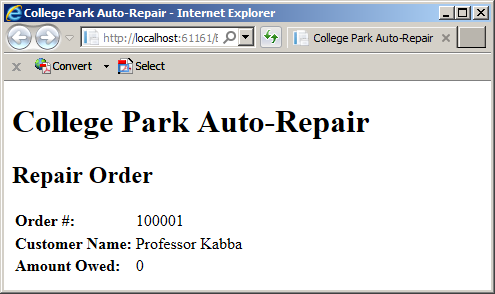
Otherwise, if you have the elements of the array, you can pass their array as argument. Here is an example:
<!DOCTYPE html>
<html>
<head>
<meta charset="utf-8" />
<style type="text/css">
.bold { font-weight: 600 }
</style>
<title>College Park Auto-Repair</title>
<script src="Scripts/angular.min.js"></script>
</head>
<body ng-app="CPARApp">
<div ng-controller="CPARController">
<h1>College Park Auto-Repair</h1>
<h2>Repair Order</h2>
<table>
<tr>
<td class="bold">Order #:</td>
<td>{{repairOrder.orderNumber}}</td>
</tr>
<tr>
<td class="bold">Customer Name:</td>
<td>{{repairOrder.customerName}}</td>
</tr>
<tr>
<td class="bold">Amount Owed:</td>
<td>{{repairOrder.repairCost(true, [24.95, 68.82, 17.74, 32.68])}}</td>
</tr>
</table>
</div>
<script type="text/javascript">
var app = angular.module("CPARApp", []);
app.controller("CPARController", ['$scope', function ($scope) {
$scope.repairOrder = {};
$scope.repairOrder.orderNumber = 100002;
$scope.repairOrder.customerName = 'Raymond Martyns';
$scope.repairOrder.repairCost = function (completed, jobsPrices) {
if (completed == true) {
var cost = 0.00;
for (var price in jobsPrices) {
cost += jobsPrices[price];
}
return cost;
}
else {
return 0.00;
}
}
}]);
</script>
</body>
</html>
This would produce:
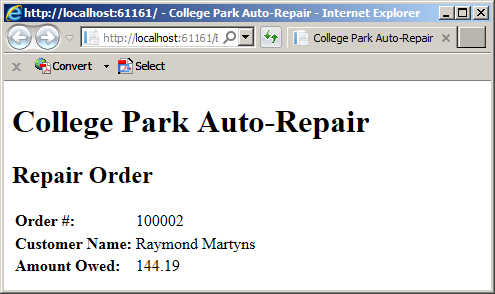
Of course, you can use the same concept if the elements of the array/arguments are objects.
|
|
||
| Previous | Copyright © 2018-2022, FunctionX | Next |
|
|
||